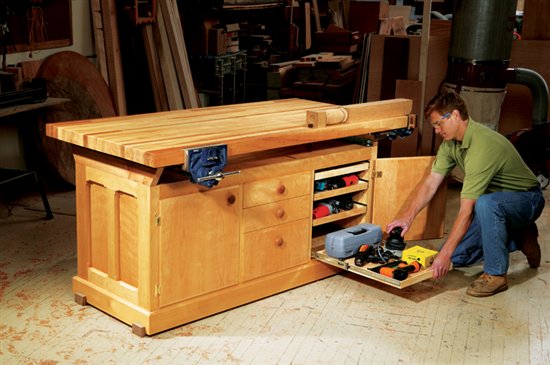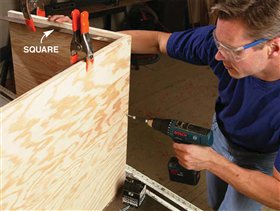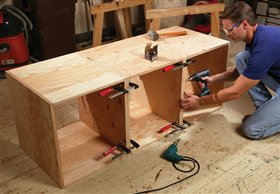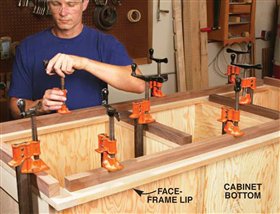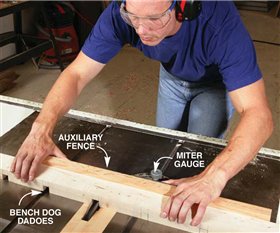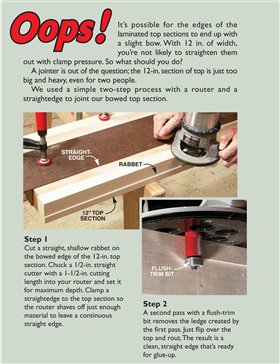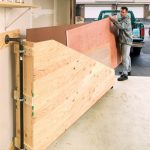We may receive a commission when you use our affiliate links. However, this does not impact our recommendations.
Dream Workbench
A modern bench that features storage, stability and mobility
By Dave Munkittrick
|
Tired of working on a sheet of plywood thrown over a pair of sawhorses? Had it with rolling benches that wiggle and wobble? Hate running around your shop whenever you need a tool? Boy, do we have the bench for you. Our dream bench starts with traditional workbench features like a thick top, a sturdy base, bench dogs and a pair of vises. Then we added tons of storage, an extra-wide top, and modern, cast-iron vises. Last but not least, we devised a simple method to make the bench mobile and still provide a rock-solid work platform. Our bench is built to withstand generations of heavy use. Simple, stout construction absorbs vibration and can handle any woodworking procedure from chopping deep pocket mortises to routing an edge on a round tabletop. The thick, butcher-block-style top is truly a joy to work on. We'll show you how to surface this huge top without going insane trying to level 24 separate strips of glued-up hardwood. Our top doesn't waste wood—even the offcuts are used. Tools & MaterialsIf you go all out like we did you can expect to pay about $900 for materials. If you can't swing that much dough all at once, don't worry; you can build an equally functional version for about $450. How? Save $220 right off the bat by substituting common 2x4s for the maple top. We made several tops this way and they work great. Just be sure you dry your 2x4s to around 8-percent moisture content before you build. You can save $75 by skipping the expensive birch plywood and hardwood. Just stick with construction lumber. The inexpensive bench may not look as classy, but hey, it's still a great workbench. You could build adjustable shelves inside the cabinets instead of drawers and pullout trays. They're less convenient, but it'll save you another $110 in drawer slides. The best thing is you can cut costs and still get a fully functional bench right away, even if you go with the least expensive options. When you've got the extra cash, you can always build the maple top or add the full-extension hardware. To build the bench you'll need a tablesaw, planer, belt or orbital sander, a router and a circular saw. You'll also want a flush-trim bit and a dado blade for your tablesaw. Build the CabinetCut the plywood parts for the three individual boxes (Parts D and E) and assemble them (Photo 1). The three boxes are joined to form the cabinet (Photo 2). Screw the two end pieces of birch plywood (H) to the cabinet, placing the screws where the face frame will cover them (Fig. A). Cut the plywood top (C) according to the actual measurements of your assembled cabinet and attach with screws. Do the same for the back (B). Cut and assemble the three face frames (parts U through AA). Use the actual measurements of your cabinet to determine rail lengths. The face frames are built slightly oversize to give you a little wiggle room when gluing them to the carcase. The extra overhang will get trimmed off later. Clamp and glue the side frames first. Tack the frames down with a couple of brad nails so they don't scoot around under clamping pressure. Use a flush-trim bit and a router to trim the side frames even with the plywood. Attach and trim the front face frame (Photos 3 and 4). To mount the drawer and pull-out shelf slides, turn the cabinet on its back and use a square to mark centerlines. Use a simple T-square jig to align the slides so the screw holes are on the line (Photo 5). The TopThis is the business end of your bench. You'll want to take extra care in each step to ensure a flat, solid top. Start by rough-cutting your top stock (EE) to length (Photo 6). Cut 3/4 in. x 3/4-in. dadoes for the bench dog (JJ) into the edge of one of the top pieces (Photo 7). Before you start to glue up the top, make use of the offcuts. Just end glue them in a line to create a full-length piece (Photo 8). I know gluing end grain is a no-no, but all you want here is to hold the pieces together long enough to build them into the top. Each segmented piece will get properly edge-glued to other full-length pieces. The result is a strong top that doesn't waste precious hardwood. Here's how to assemble the butcher-block top without facing a sentence of hard labor sanding. Glue up three 12-in. sections of the top on a flat surface. We flipped the cabinet face down and used the back for our glue-up (Photo 9). Each 12-in. section should start and end with a full-length piece. The segmented pieces can alternate with full-length pieces. Once the Now you're going to put your Once all three sections are surfaced, you can glue them together Once all the sections are glued Install the VisesInstalling the vises is pretty Install the face vise on the top.Then The smaller tail vise only needs a Build the Base
Build the base flush with the bottom of the cabinet. Pick the Doors, Drawers & Pull-Out Shelves
Start by cutting three door blanks (J). Add the 1/2-in.-birch edging on Sources:(Note: This information may have changed since this story's original publication date.) Home Center, Four sheets 3/4" AC fir plywood, $27 ea. ($108 total); One
Grand total: $899.25. Cutting ListFig. A: Exploded ViewFig. B: Plywood Cutting DiagramFig. C: Drawers and Pullout ShelvesThis story originally appeared in American Woodworker January 2004, Issue #105. |
Click any image to see a larger version. Tons of easy-access storage: Extra-wide, heavy-duty top: You name it, this bench can clamp it down: It's rock-solid but mobile: 1. Start the base cabinet by assembling three identical boxes with butt joints and screws. Make sure all the parts are square and the joints are flush. Use a flat area, like the top of your tablesaw, to help keep things in line. 2. Screw the three boxes together to create the cabinet base. Use clamps to hold the boxes flush and even. 3. Glue and clamp face frames to the cabinet. Start with the side frames. Then add the front face frame so it overhangs the bottom of the cabinet to form a lip for the 2×4 base you'll build later. 4. Trim the face frame flush to the cabinet sides. Use a stop block at the top of the cabinet openings to prevent the router from cutting into the upper rail. 5. Attach the drawer slides to the cabinet. A simple T-square jig positions the slide for quick installation. Stop blocks hold the slides 1/2 in. back from the front edge for the half-overlay doors. The doubled-up box sides automatically flush up with the 1-1/2-in.-wide face frame so there's no need to add blocks for the drawer slides. 6. Cut pieces for the benchtop, making them 2-in. longer than the finished top. Don't toss the offcuts into the firewood pile. We'll build them into the top so nothing goes to waste. 7. Cut dadoes for the bench dog holes in one of your benchtop pieces. Use a dado blade and a miter gauge with a long auxiliary fence to support the stock. The slots are marked on the top of the piece. It's okay to eyeball each cut. Exact spacing of the holes is not critical. 8. Glue together the offcuts end to end. Clamp them between two full-length pieces to keep them straight. This yields a few more strips for the top and uses up your offcuts. Waxed paper around the joint keeps the segmented strip from sticking to the full-length pieces. We used the back of the cabinet for a flat glue-up table. 9. Glue eight strips together to form one 12-in. section of the top. Cauls keep the top pieces in alignment. The bench dog piece is placed second from the edge with the dadoes facing toward the front edge. 10. Plane each 12-in. section flat. Take light cuts and make sure your planer knives are sharp, to minimize tear-out. Outfeed support is essential when planing heavy stock like this. 11. Clamp the 12-in. sections together one at a time. You only have one joint to worry about so make it flush. Extra effort here will pay off in the end. You'll only have to lightly sand for a flat, smooth top. 12. Mount the face vise, then glue two strips on either side. This will make the front edge of the top flush with the wooden cheek of the vise. 13. Screw the cabinet onto the base and nail on the base molding. If your bench is going to be mobile, use glue as well as nails to prevent the molding from being inadvertently pried off when the bench is lifted. 14. Place the benchtop on the cabinet. This top is heavy, so get a friend to help with the lifting. Check for an even overhang on all four edges. Then secure with lag bolts. |
Here are some supplies and tools we find essential in our everyday work around the shop. We may receive a commission from sales referred by our links; however, we have carefully selected these products for their usefulness and quality.



